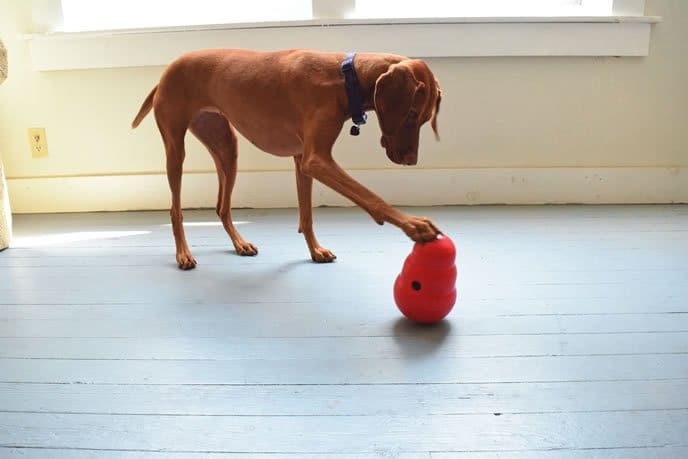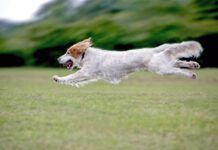Like us, our dogs need both physical exercise and mental stimulation. As a trainer, I see many clients who focus on physical exercise, but don’t always consider the benefits of mental stimulation – what I call brain-work. One easy way to add in a bit of brain-work is to get rid of your dog’s food bowl and replace it with other fun feeding options. I’m always so excited to share with my clients how fun and effective it can be to ditch the dish! Yes, that’s right: Throw that traditional food bowl into the trash and get going with creative feeding.
There are a number of benefits of ditching the dish:
— Enrichment. The big-picture benefit is enrichment, a process for improving the environment and behavioral care of confined animals. If you don’t think of your dog as “confined,” think again. Compared to the life of a feral dog, our pet dogs live in incarceration. They go only where we allow them to go, oftentimes only on leash, and they rarely get a choice in their activities. By focusing on enrichment, in addition to nutrition and healthcare, you can reduce stress and improve your dog’s well being by providing not only physical, but also mental stimulation.
— Taking advantage of your dog’s natural foraging or scavenging instincts. As Alexandra Horowitz shares in her book, Inside of a Dog: What Dogs See, Smell, and Know (an awesome book by the way), dogs naturally scavenge or hunt singularly (not in packs). Think about how your dog, off leash, naturally takes off to explore the ground with his nose. Providing an outlet for this instinctive behavior is fantastic for your dog.

— Outlet for chewing, a typical behavior for canines. Ahhh, chewing! While deemed an unwanted behavior by many owners, it’s a natural behavior for all types of canines. By providing opportunities for your dog to chew through the use of a creative feeding option, you’ll have less chewing of objects that you really did not want chewed!
— Brain work. In the wild, dogs spend a great deal of their waking time trying to obtain food. Think of the mental (and certainly physical) exercise this quest demands. Plopping down an entire bowl of food and having your dog gobble it up in less than a minute certainly nixes nature’s design. Drawing out the length of time it takes your dog to eat, and having him work to get the food out of something other than a traditional food bowl, adds fantastic mental stimulation.
If the dish is gone, what will you use? There is a plethora of options today. You can purchase food toys, interactive food toys, or food puzzles—or you may consider feeding your dog’s meals by hand or other creative means.
Dog Food Toys and Dog Food Puzzles
The terms food toys, interactive food toys, and food puzzles are used interchangeably. These are objects that can hold food and require the dog to work to find or get the food out of the object. They require both mental and physical dexterity to access the food. A quick Google search will pull up more options than you likely have time to look at, so I’ll mention a few of the most popular food toys that I and other trainers use for our own dogs and recommend to clients.
■ Kong Classic. We’ve been using the Kong Classic for nearly 20 years, long before it was called classic (I guess I just dated myself). These are a staple in our home. It’s a super-bouncy, natural rubber toy that has a large opening in the bottom and a small opening on the top. It is easily stuffed with all manner of tasty hard and soft foods. The Kong Classic comes in a variety of rubber strengths, so choose the toughest for those hard-chewing dogs.
■ Kong Wobbler. The Wobbler is a food-dispensing toy that is weighted on the bottom and sits upright until pushed by a dog’s nose or paw and then periodically dispenses as it wobbles and rolls around. The unpredictable movement keeps dogs challenged. It unscrews for easy filling and cleaning.
■ Nina Ottosson Puzzle Toys. There are so many interesting and creative options offered by Nina Ottosson and her products are very well made. Each is designed to stimulate a dog’s brain and reinforce his relationship with his guardian. The puzzles can be set to different levels of complexity. Start with the easier puzzles and as your dog gains skills, you can move to more challenging puzzles.
■ Zanies Wood Interactive Puzzle Pizza. This interactive toy is a wooden design that allows you to put treats under the standing or sliding pegs. The dog has to figure out how to solve the puzzle to get to the treats.
Slow-Feeders
Slow-feeding bowls do exactly what you think they’ll do: slow down the pace at which your dog eats his meal. Meal time may be extended from 30 seconds to 5 to 10 minutes or more. Again, there are lots of options. Here are two favorites:
■ Kyjen Slo Bowl. The Slo Bowl is a round plastic bowl that comes in different shapes and sizes and resembles a maze. It’s deeper in the middle and shallower on the edges. The bowl has small rubber pads on the bottom to keep it from slipping on hard surfaces. Dogs quickly learn to work their way through the maze of ridges; it makes meal time feel more like a hunt for food!
■ Green Interactive Slow Dog Feeder. The Green by Northmate is made of a durable hard plastic and the company says it’s shaped like tufts of grass. I think of it as a small green mountain range. You can scatter dry food or smear wet food throughout the peaks and valleys of the feeder to prolong your dog’s meal and make it a challenging game.
Homemade Dog Food Toys
If you’re on a limited budget, you can craft your own interactive food toys. With a few simple household items and creativity, you can easily make meal times challenging and fun for your dog. Note that while these homemade toys are inexpensive and easy to craft, they are also easy for your dog to chew up and destroy, so give them to your dog under active observation, and take them away when he’s finished removing all the food.
■ Muffin Pan Puzzle. Take a muffin pan, place a treat or a bit of your dog’s meal in each cup, cover each treat with a tennis ball and watch as your dog has fun lifting up the tennis ball to get to the food. Another option is to turn the muffin pan upside down and sprinkle your dog’s food in the valleys around the now protruding cups. Ta-da! It’s a slow feeder.
■ Plastic Container Food Toy. Take a used yogurt container or milk jug, cut several holes in and around the container, file or sand down any sharp or rough edges, fill with food and replace the lid. Your dog will have fun nosing and pawing the toy to extract the food.
■ Box Food Toy. Just like children have fun with boxes, so do most dogs. With a box appropriately sized for your dog, sprinkle your dog’s food in the bottom of the box, close the lid by interlacing the flaps (not taping) and let the fun begin. If that’s too challenging for your dog, you can also cut a few small holes in the sides of the box so that the food pops out when the dog moves the box about.
■ Peanut Butter Jar Puzzle Toy. Take a used, clean, plastic jar, medium- to large-sized. Cut a dime-sized hole in the lid of the jar; it helps if the hole is not in the center. To make this toy dispense food at a higher rate, you can cut additional holes in the sides and bottom of the jar. Place three cardboard tubes (from a roll of paper towels or plastic wrap) inside the jar, fill the tubes with your dog’s kibble, and screw on the lid. As the dog pushes the jar around with nose or paws, the food randomly dispenses from the holes in the jar.
(For a short video that shows how to do this, see this video.)
As with all new and unusual things, slowly introduce your dog to the new food puzzle toy. You know your dog best, so if she’s anxious about approaching new things, take it slow and help her develop a positive association with this new, exciting contraption. Depending on the type of food toy you select, you may also need to help your dog learn how to access the food. Set her up for success. Make it easy for her to succeed the first time, so she’ll be eager to try it again and before you know it, she’ll be acing those complex puzzles!
Hand Feeding Your Dog
I often recommend hand feeding to my clients, most often when there’s a new dog in the home who is just beginning to learn house manners.
I suggest delivering the dog’s food one tiny treat or piece of kibble at a time during several short daily training sessions, as well as using the dog’s food to reinforce all the other wonderful choices the dog makes each day. Behaviors that get reinforced get repeated! What better way to help our fabulous furry friends learn to navigate in our crazy alien (human) world.
Other times, I recommend this practice because the dog may be hand-shy and I want her to understand that a hand coming toward her means “good things happen” – yummy food appears!
Another form of hand-feeding is what I call “scattering and scavenging,” which is scattering your dog’s food around your house and letting her scavenge to find it. It’s an easy way to take advantage of your dog’s natural seeking instincts. Place some kibble behind a chair, under the edge of the bed, behind the recliner, then let her “go find” it.
Outside, you can place food behind trees and under or beside rocks. Get creative, but don’t put food anywhere you don’t want your dog to explore!
This game can be a great way to reinforce a “stay” cue. Ask your dog to stay while your scatter the food in a variety of places, then release her and enjoy watching her having a blast tracking down her meal.
Final Notes
Not all puzzle toys are created equal. Do your research to select high-quality products that are less likely to fall or break apart. Keep in mind that no toy is indestructible, so inspect your puzzle toys frequently for cracks and other pieces that could come loose. If you have a multi-dog household and your dogs don’t share well, it’s best to use interactive food toys with your dogs in separate rooms or tethered apart from one another. As with all things your dog eats from, don’t forget to keep the toy clean by washing it frequently.
Remember, ditching the dish gives your dog a creative feeding option that will help her expend energy, work her brain, and enrich her life. She will thank you for it!
Lisa Lyle Waggoner is the founder of Cold Nose College in Murphy, North Carolina, with additional locations in Atlanta, Georgia, and the Space Coast of Florida.





